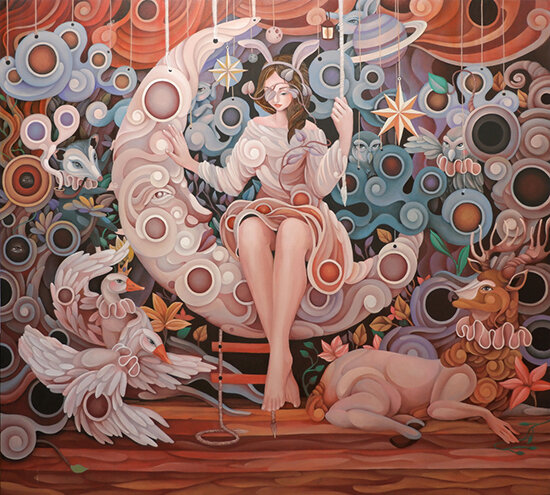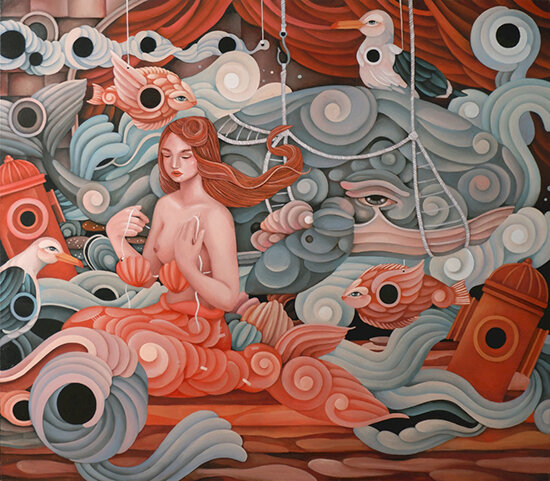These Violent Delights - Act 1
Enter Stage Left
In These Violent Delights, Iyan de lesus’ fourth solo exhibition, all her world's a stage, each scene translated beautifully on canvas. With the artist intending a three-act exhibition, the first act mounted at the Artemis Gallery, we are introduced to recent works that launches a detailed playhouse and memorable characters set up for an enigmatic and breathtaking continuing narrative.
Scene 1 is the Moon Landing Conspiracies, presenting a character using a fake moon which is obviously part of a set as a swing. A child of the night, she is comforted not only by her nocturnal adventures but her companions as well, all as part of a daydream sequence where she is fully awake and aware that the moon is a nurturing part of her life. It seems that whatever struggles day brings, the night cloaks her in strength that enables her to play any role required of her.
The second scene takes us to a portrayal of Macbeth in Fair is Foul and Foul is Fair, presenting the three witches or Weird Sisters, who instead of being old crones are transformed into young, pretty ladies who encounter a rare treat: instead of a prince, knight or a king, a decorated, plumed and caped cat arrives on an equally flamboyant horse while mice and other animal friends scamper about. Since ancient Egyptian times, cats have been worshiped, and perhaps for good reason: it is said that one does not own a cat, but a cat owns a human. This directly translates to society’s fascination with cute fur balls that we do not mind dedicating our lives to, and the artist happily reminds us that we consider cats now as more powerful than kings.
Scene 3, Under Pressure takes us to water as we find a mermaid who seems to be in the midst of a costume change. As she wears the outfit required of her, she steels herself for the role she intends to play. Creatures from both the sea and sky frolic in the waves and the water’s surface. Fire hydrants float, instead of being rooted firmly on the ground, and gulls stay closer to the water while fish fly which may be signifiers of society’s preconceived standards, especially required for the youth of today. With this, each individual hopefully keeps courage in being her or himself and keeping one’s values intact while pressure abounds from external factors such as social media and restrictive traditional constraints.
For Scene 4, the artist prepares a glorious tableau in And Then They Danced the Strings Away, featuring marionettes that are finally letting go of strings that hook them to toxic attachments. Flamingos of blazing pink feathers flit and flutter amongst threads snapped by maidens underneath a canopy of curtains, carvings and mirrors. As the characters find their own strengths to move, in the directions they actually want, they knowingly subject themselves to exhaustion, but there is also an element of exhilaration brought about by independence and lightness due to detachment. The question, perhaps, is where do they go, and what happens next?
With de Jesus’ familiar characters come twists and tangles thrown in for good measure: each piece sets off a start, swirls, circles, waves, lines and pastel colors creating a self-contained story that may be enjoyed in itself. Indeed for the artist, “life is a theatrical performance of mundane events; a first dress rehearsal and script reading where all stage direction is vague and most actions, improvised.” As we witness these stunning, excessively abundant productions, we await with bated breath for the next act.



